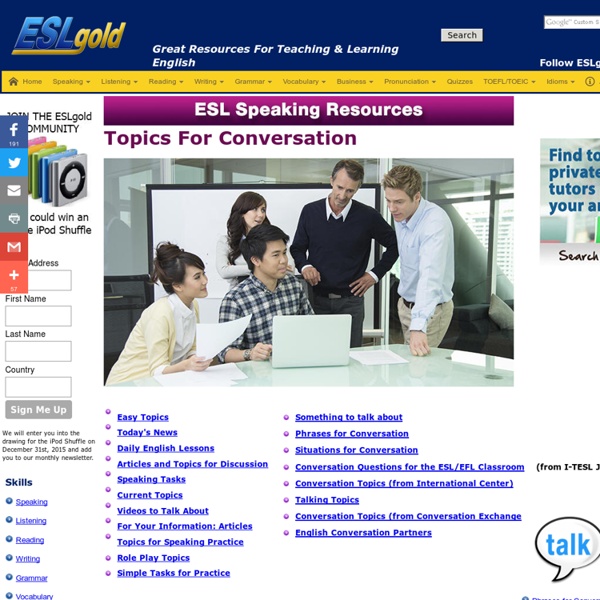



http://www.eslgold.com/speaking/topics_conversation.html
English Vocabulary (For ESL Students) Hangman Guess the letters in the mystery words. (About 60 games) Hangman - JHS Words Guess the letters in the mystery words. The words are limited to those appearing on the Junior High School Word List from the Ministry of Education in Japan. COMMUNICATION SKILLS: The Do's and Don'ts of Body Language in Public Speaking If I were to ask you, of all the time you put into preparing a speech, presentation or any other public speaking event, how much of that time is spent on practicing and preparing your body language, most would say very little. The majority of your time would be spent on preparing the content for the event – collecting the information, synthesizing it and building the proverbial PowerPoint. Likewise, when we practice, we typically practice what we’re going to say, not necessarily how we’re going to say it.
Festival WebQuests: St Patrick's Day Who was St Patrick, and what is the history of St Patrick’s Day? Find the answers in this webquest, and learn about how 17th March is celebrated around the world. On the 17th March, the whole world becomes Irish. It’s the day we celebrate St Patrick’s Day in honour of Ireland’s patron saint. But who was St Patrick? Describing photos (comparing, contrasting and speculating) You are going to practise language for; Describing photosComparing and contrasting photos (discussing similarities and differences)Speculating on what might be happeningReacting to photos (giving opinions) Discuss Look at the presentation. Follow the instructions and talk about some of the photos
Corn encyclopedia topics corn, in botany. The name corn is given to the leading cereal crop of any major region. In England corn means wheat; in Scotland and Ireland, oats. The grain called corn in the United States is Indian corn or maize ( Zea mays ). English Speaking and conversation practice and activities for ESL students and teachers Speak-English-Today.com is an online meeting place for English students and teachers from around the world. We will help link you to personal tutors, conversation partners, or others who want to talk in English. Our network includes thousands of students, so you can begin practicing right away! It's free to sign up and chat with other students and conversation partners.
Discussion topics for English language learners Prepare for Discussion 28 topics-- for the Higher Intermediate & Advanced levels----START 01 Alternative Beliefs Speaking Welcome to EnglishClub.com Speaking for ESL learners, to help you learn and practise the skill of speaking English. Speaking is the second of the four language skills, which are: 1. Listening 2. Speaking 3. Reading 4.